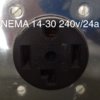Breaker box is full, trying to figure out my options, hoping for something simple. Seems some of the smaller amp breakers can be combined to make rom for a 14-50 outlet, but I don't understand how yet. Thanks.
There is physically full, and main panel/breaker out of capacity.
The physical issue can usually be solved by so-called "pancake," "skinny," or "thin" breakers. For example, here is a Siemens product that puts two 20 Amp single pole breakers in the space of one normal single pole breaker,
Siemens Q2020 Two 20-Amp Single Pole 120-Volt "Thin" Circuit Breakers - Amazon.com If you replace four existing singe pole breakers with two of these, then you make the physical space available for one high power (30, 50, or 100 Amp) two-pole, 240 Volt breaker.
The Amperage capacity of the panel, service entrance, or main breaker is the second constraint that you have to worry about. There are several ways to calculate this depending on your location and inspector policies, but basically the calculations want to make sure that there is an extremely low chance of going over 80% of the main breakers rating for any lengthy periods of time. Such events would probably trip the main breaker, a big annoyance, and something you want to avoid.
Your electrician should be able to see if your circuit breaker panel can accept the skinny, thin breakers, and do the load calculations to see if the panel can support a large 240 Volt circuit. If you electrician says he can't do the research, or "it can't be done," get a second opinion.
Good Luck!






